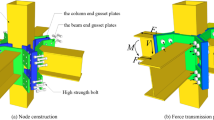Abstract
The modified pseudo-dynamic method is introduced in the paper at first, then geometric model of anchoring characteristics of rock slope considering nonlinear twin-shear criterion subjected to seismic loads is established. Finally some correlated influential parameters on the anchoring characteristics of rock slope are analyzed, the conclusions are drawn that the minimum total anchoring force f increases as the increase of bolt inclination angle \(\alpha\), unit weight \(\gamma\) and horizontal seismic acceleration coefficient kh; And minimum total anchoring force f decreases as the increase of internal friction angle \(\phi\), vertical seismic acceleration coefficient \(k_{\text{v}}\), the geometric parameters mi and GSI and uniaxial compression strength \(\sigma_{c}\); when internal friction angle \(\theta\) is in certain range (\(\theta \le 18.1^{ \circ }\)), the value of total anchoring force becomes smaller as the value of \(\theta\) and \(\phi\) increases, the slope becomes safer. These conclusions can bring great theoretical value to analyze anchoring characteristics of rock slope.









Similar content being viewed by others
References
Anindya P, Deepankar C, Bhattacharyya SK (2017) Seismic rotational stability of gravity retaining walls by modified pseudo-dynamic method. Soil Dyn Earthq Eng 94(3):244–253
Bellezza I (2014) A new pseudo-dynamic approach for seismic active soil trust. Geotech Geol Eng 32(2):561–576
Chen WF, Liu XL (1990) Limit analysis in soil mechanics. Elsevier, Amsterdam
Choudhury D, Katdare AD (2013) New approach to determine seismic passive resistance on retaining walls 337 considering seismic waves. Int J Geomech 13(6):852–860
Choudhury D, Ivatdare AD, Pain A (2014) New method to compute seismic active earth pressure on retaining wall considering seismic waves. Geotech Geol Eng 32(2):391–402
De BP, Manglavacchi R, Nova R et al (1989) Yield design of reinforced earth walls by a homogenization method. Geotechnique 39(2):189–201
Giridhar R, DeepanKar C (2017) Stability of seawalls using modified pseudo-dynamic method under earthquake conditions. Appl Ocean Res 65(3):154–165
Hoek E, Brown ET (1980) Empirical strength criterion for rock masses. ASCE J Geotech Geoenviron Eng 106(9):1013–1035
Jahanandish M, Kehavarz A (2005) Seismic bearing capacity of foundations on reinforced soil slopes. Geotext Geomembr 23(1):1–25
Jewell RA (1987) Revised design charts for steep reinforced slopes. In: Shercliff DA (ed) Reinforced embankments: theory and practice, vol 349. Thomas Telford, London
Ling HI, Leshchinsky D, Perry EB (1997) Seismic design and performance of geosynthetic-reinforced soil structures. Geotechnique 47(5):933–952
Lu CP, Dou LM, Zhang N, Xue JH, Wang XN, Liu H, Zhang JW (2013) Microseismicfrequency-spectrum evolutionary rule of rockburst triggered by roof fall. Int J Rock Mech Min Sci 64(2):6–16. https://doi.org/10.1016/j.ijrmms.2013.08.022
Maghous S, De BP, Bekaert A (1998) Failure design of jointed rock structures by means of a homogenization 358 approach. Mech Cohesive-Frict Mater 3(3):207–228
Michalowski RL, Zhao A (1995) Continuum versus structural approach to stability of reinforced soil. J Geotech Eng 121(2):152–162
Michelis P (1987) True triaxial cyclic behavior of concrete and rock in compression. Int J Plast 3(3):249–270
Mogi K (1971) Effect of the triaxial stress system on the failure of dolomite and limestone. Tectonophysics 11(2):111–127
Porbaha A, Zhao A, Kobayashi M et al (2000) Upper bound estimate of scaled reinforced soil retaining walls. Geotext Geomembr 18(6):403–413
Saada Z, Maghousb S, Gamier D (2011) Seismic bearing capacity of shallow foundations near rock slopes using the generalized Hoek–Brown criterion. Int J Numer Anal Methods Geomech 35(6):724–748
Sawada T, Nomachi SG, Chen WF (1994) Seismic bearing capacity of a mounded foundation near a down-hill slope by pseudo-static analysis. Soils Found 34(1):11–17
Serrano A, Olalla C (1994) Ultimate bearing capacity of rock masses. Int J Rock Mech Mining Sci 31(2):93–106
Singh DN, Basudhar PK (1993) Determination of the optimal lower-bound-bearing capacity of reinforced soil-retaining walls by using finite elements and non-linear programming. Geotext Geomembr 12(7):665–686
Srbulov M (2001) Analysis of stability of geogrid reinforced steep slopes and retaining walls. Comput Geotech 28(4):255–268
Yu M, Zan YW, Zhao J (2002) A unified strength criterion for rock material. Int J Rock Mech Min Sci 39(8):975–989
Zhao YX, Han M, Bao YF (1990) Variation of P-wave Q-values during the fracture process of marble specimens under true triaxial compression. Phys Chem Earth 17(1):91–97
Zhao A, Montanelli F, Rimoldi P (1996) Design of reinforced foundations by the slip-line method. In: Proceedings of the earth reinforcement, Ochiai, Japan, pp 709–714
Zhou XP, Ji X, Qian QH (2012) Stability analysis of water front retaining wall subjected to seismic loads using pseudo-dynamic method. Chin J Rock Mech Eng 31(10):2071–2081 (in Chinese)
Zhou XP, Cheng H, Feng YF (2014) An experimental study of crack coalescence behaviour in rock-like materials containing multiple flaws under uniaxial compression. Rock Mech Eng 47(6):1961–1986
Zhou XP, Gu XB et al (2016) Seismic bearing capacity of shallow foundations resting on rock masses 387 subjected to seismic loads. KSCE J Civ Eng 20(1):216–228
Acknowledgements
This work is supported by the first batch of Natural Science Foundation of SiChuan Provincial Department of Education (No. 17ZA0270); Talent Introduction Projection in 2016 in SiChuan University of Science and Engineering (No. 2016RCL19); The open foundation item in key laboratory about nondestructive testing and engineering calculation in university in 2016 (No. 2016QYJ02); science and technology project of safety production in SiChuan province (aj20170601105926).
Author information
Authors and Affiliations
Corresponding author
Additional information
Publisher's Note
Springer Nature remains neutral with regard to jurisdictional claims in published maps and institutional affiliations.
Rights and permissions
About this article
Cite this article
Gu, X.B. The Analysis of Anchoring Characteristics of Rock Slope Based on the Nonlinear Twin-Shear Criterion Subjected to Seismic Loads. Geotech Geol Eng 38, 6343–6352 (2020). https://doi.org/10.1007/s10706-020-01439-7
Received:
Accepted:
Published:
Issue Date:
DOI: https://doi.org/10.1007/s10706-020-01439-7




